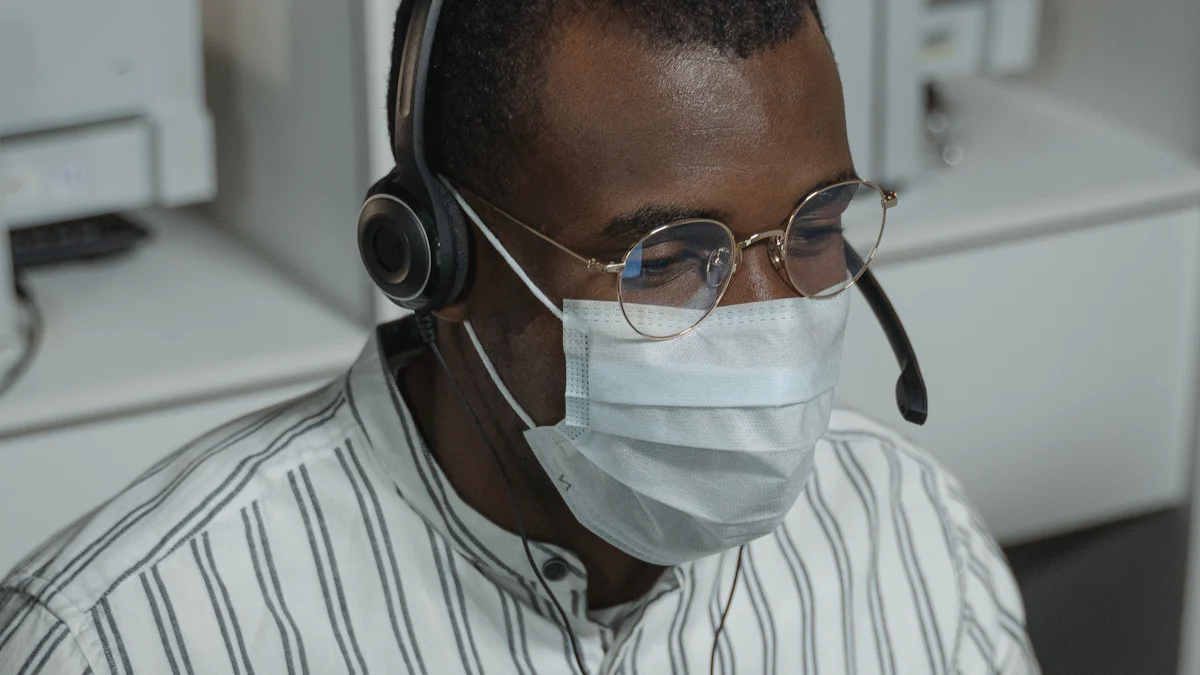How to Choose the Best Headphones for Online Meetings

Choosing the right headphones for virtual meetings can make a world of difference. Imagine trying to focus on a call, but all you hear is muffled voices and background noise. Not fun, right? That's why having the best headphones for virtual meetings is crucial. They ensure crystal-clear communication, allowing you to catch every word without straining. Good audio quality not only enhances your meeting experience but also boosts your professional image. After all, poor sound quality can ruin a meeting and leave a bad impression. So, investing in quality headphones is a smart move for anyone who frequently participates in virtual calls.
Key Takeaways
- Investing in high-quality headphones enhances audio clarity, ensuring effective communication during virtual meetings.
- Prioritize sound quality and microphone performance to avoid misunderstandings and maintain professionalism.
- Choose between wired and wireless options based on your need for stability versus mobility during calls.
- Consider comfort and fit, especially for long meetings, to prevent fatigue and distractions.
- Test your headphones before meetings to ensure optimal sound and microphone quality, enhancing your overall experience.
- Regular maintenance, such as cleaning and proper storage, can extend the life of your headphones and keep them performing well.
- Select the right type of headphones (over-ear, in-ear, noise-canceling) based on your environment and personal preferences for the best audio experience.
The Importance of Audio Quality in Virtual Meetings
In the world of virtual meetings, audio quality plays a pivotal role. Imagine you're on a conference call, and the sound keeps cutting out. Frustrating, right? That's why ensuring high-quality audio is essential. It not only makes communication smoother but also enhances your professional image. Let's dive into how audio quality impacts communication and productivity.
Impact on Communication
When you're in a virtual meeting, clear communication is key. Poor audio can lead to misunderstandings and missed information. According to experts, "The first and most important component of an effective video meeting is audio quality." If participants can't hear you properly, the meeting's purpose gets lost. High-quality audio ensures that every word is heard clearly, making your message more impactful.
Moreover, a study by the University of Southern California and the Australian National University found that audio quality influences whether people believe what they hear. This means that better sound can actually make your words more credible. So, investing in a high-quality conferencing solution can significantly improve your communication during video calls.
Professionalism and Productivity
High-quality audio doesn't just affect communication; it also boosts professionalism and productivity. Imagine attending a meeting where the sound is crisp and clear. It sets a positive tone and shows that you value the meeting's importance. On the other hand, poor audio can make you seem unprepared or unprofessional.
In addition, good audio quality can enhance productivity. When you don't have to strain to hear or repeat yourself, meetings become more efficient. You can focus on the content rather than technical issues. As the Webex Blog points out, overcoming audio anxiety is crucial for effective video conferencing. By using reliable audio solutions, you can ensure that your meetings run smoothly and productively.
Key Features to Consider When Choosing Headphones

When you're on the hunt for the perfect headphones for online meetings, several key features should guide your decision. Let's break down what you need to look for to ensure you get the best experience possible.
Sound Quality
Sound quality is the heart of any good pair of headphones. You want to hear every word clearly, without distortion or interference. High-quality sound ensures that you can focus on the conversation rather than struggling to understand what's being said. Bose QuietComfort Ultra Headphones are a great example, offering excellent sound and noise-canceling capabilities. They even include an Immersive Audio feature that enhances sound quality, making them a top choice for virtual meetings. When evaluating sound quality, consider the clarity of the audio and the balance of bass and treble. A quality headset will provide a natural bass response and clear sound, ensuring you don't miss a beat during your calls.
Microphone Quality
A good microphone is just as important as sound quality. You want your voice to come through clearly to others in the meeting. Headphones with microphone capabilities should offer clear speech reproduction and effective noise cancellation. This ensures that your voice is heard without background noise interfering. The Best Headphones with Mic are designed for two-way communication, providing class-leading noise cancellation and audio quality. When choosing a headset, pay attention to the microphone's ability to pick up your voice accurately and reduce ambient noise.
Comfort and Fit
Comfort is crucial, especially if you spend long hours in meetings. You don't want a headset that feels heavy or causes discomfort after a short period. Look for headphones that offer a snug fit without being too tight. The best options are lightweight and have cushioned ear pads that provide comfort during extended use. A well-fitting headset not only enhances comfort but also improves sound quality by creating a better seal around your ears. This helps in blocking out external noise, allowing you to focus on the meeting.
Connectivity Options
When choosing headphones for online meetings, connectivity options play a crucial role. You want a stable connection that ensures uninterrupted audio. Let's explore the different connectivity choices available.
Wired vs. Wireless
You might wonder whether to go for wired or wireless headphones. Each has its perks. Wired headphones often provide a more stable connection. They reduce audio latency, which is a delay between the sound being produced and heard. This stability makes them a popular choice for virtual meetings. You plug them in, and you're good to go. No worries about battery life or interference.
On the flip side, wireless headphones offer freedom of movement. You can walk around without being tethered to your device. This flexibility can be a game-changer, especially if you like to pace while talking. However, they rely on battery power and can sometimes experience connectivity issues. It's essential to weigh these factors based on your needs.
Bluetooth Compatibility
If you lean towards wireless options, Bluetooth compatibility becomes vital. Most modern devices support Bluetooth, making it a convenient choice. Bluetooth headphones vary in microphone quality, so it's crucial to choose a model that offers clear speech reproduction. Some models excel in this area, providing excellent audio and microphone quality.
When selecting Bluetooth headphones, consider the version of Bluetooth they support. Newer versions offer better connectivity and sound quality. Also, check if they have features like Active Noise Cancellation, which can enhance your listening experience by reducing background noise.
Comparing Different Types of Headphones for Better Audio Quality

When it comes to choosing the right headphones for your online meetings, understanding the different types available can help you make an informed decision. Each type offers unique features that cater to various needs and preferences. Let's explore some popular options to find out which one suits you best.
Over-Ear Headphones
Over-ear headphones are a popular choice for those seeking high-quality audio. These headphones cover your entire ear, providing excellent sound isolation. This design helps block out background noise, allowing you to focus on your calls without distractions. Over-ear models often deliver better audio quality with deep bass and clear treble, making them ideal for professional settings.
Many users appreciate the comfort of over-ear headphones, especially during long meetings. The cushioned ear pads and adjustable headbands ensure a snug fit, reducing fatigue. If you prioritize comfort and immersive sound, over-ear headphones might be the perfect choice for you.
In-Ear Headphones
In-ear headphones, also known as earbuds, offer a compact and portable solution for online meetings. They fit snugly inside your ear canal, providing decent sound quality and noise isolation. While they may not match the audio depth of over-ear models, in-ear headphones excel in convenience and mobility.
These headphones are perfect for those who are always on the go. You can easily slip them into your pocket or bag, making them a great option for quick calls or meetings. In-ear headphones are also less conspicuous, which can be beneficial if you prefer a more discreet look during video conferences.
Noise-Canceling Headphones
Noise-canceling headphones are a game-changer for anyone who frequently deals with background noise during calls. These headphones use advanced technology to actively reduce ambient sounds, ensuring you hear only what matters. Whether you're in a bustling office or a noisy home environment, noise-canceling headphones provide a serene listening experience.
The high-quality audio delivered by noise-canceling headphones enhances your communication by eliminating distractions. You can focus entirely on the conversation, making your calls more productive and enjoyable. If you often find yourself in noisy surroundings, investing in noise-canceling headphones can significantly improve your meeting experience.
Open-Back vs. Closed-Back Headphones
When you're choosing headphones for online meetings, understanding the difference between open-back and closed-back designs can help you achieve better audio quality. Each type offers unique benefits, so let's dive into what makes them distinct.
Open-Back Headphones: These headphones have ear cups that allow air and sound to pass through. This design creates a more natural and spacious sound, making you feel like you're in the same room as the person speaking. Open-back headphones are great if you want an immersive audio experience. However, they do let in external noise, which might not be ideal if you're in a noisy environment. If you prioritize sound quality and don't mind some background noise, open-back headphones could be your go-to choice.
Closed-Back Headphones: In contrast, closed-back headphones have sealed ear cups that block out external sounds. This design provides excellent sound isolation, allowing you to focus entirely on your meeting without distractions. Closed-back headphones often deliver a more intense bass response, which can enhance the clarity of voices during calls. If you need to concentrate in a busy setting, closed-back headphones offer better audio quality by minimizing outside interference.
Here's a quick comparison to help you decide:
-
Sound Experience:
- Open-Back: Natural, airy sound; less isolation.
- Closed-Back: Isolated, focused sound; better for noisy environments.
-
Use Case:
- Open-Back: Ideal for quiet settings where you want a realistic audio experience.
- Closed-Back: Perfect for busy areas where you need to block out noise.
Choosing between open-back and closed-back headphones depends on your specific needs. If you value a natural sound and are in a quiet space, open-back might be the way to go. But if you need to shut out the world and concentrate, closed-back headphones will provide the better audio quality you seek.
Practical Tips for Testing and Maintaining Headphones
Choosing the right headphones is just the beginning. To ensure they serve you well during online meetings, you need to test and maintain them properly. Here are some practical tips to help you get the most out of your headphones.
Testing Sound and Microphone Quality
Before diving into a virtual meeting, it's crucial to test both the sound and microphone quality of your headphones. Here's how you can do it:
-
Sound Check: Play a variety of audio tracks to evaluate the sound quality. Listen for clarity and balance in the bass and treble. Over-ear headphones often excel in delivering high-fidelity audio, providing a rich listening experience.
-
Microphone Test: Record your voice using the microphone and play it back. This helps you assess how clearly your voice comes through. Make sure there's minimal background noise interference. If possible, test the microphone in different environments to see how it handles ambient sounds.
-
Noise Cancellation: If your headphones have noise-canceling features, test them in a noisy environment. Over-ear models usually offer superior noise cancellation due to their tight seal around the ear. This feature is essential for blocking out background noise during meetings.
Maintenance and Care Tips
Proper maintenance can extend the life of your headphones and keep them performing at their best. Follow these care tips:
-
Regular Cleaning: Wipe down your headphones with a soft, dry cloth after each use. This prevents dirt and oils from building up. For in-ear models, clean the ear tips regularly to maintain hygiene and sound quality.
-
Safe Storage: Store your headphones in a protective case when not in use. This prevents damage from accidental drops or pressure. In-ear headphones are particularly portable, so keeping them in a case can prevent tangling and wear.
-
Cable Care: If you use wired headphones, avoid wrapping the cable tightly around the device. This can cause wear and tear over time. Instead, loosely coil the cable to prevent damage.
-
Battery Management: For wireless headphones, charge them regularly but avoid overcharging. This helps maintain battery health and ensures they’re ready for your next meeting.
By testing and maintaining your headphones, you ensure they deliver optimal performance during every online meeting. These simple steps can make a significant difference in your audio experience.
Choosing the best headphones for virtual meetings can transform your conference calls into seamless experiences. Remember, sound quality is crucial. Whether you prefer open-back headphones for their natural sound or closed-back ones for better noise cancellation, each type has its perks. Consider your specific needs and environment. Are you often in noisy settings? Closed-back might be your go-to. Do you value a realistic audio experience? Open-back could be ideal. Ultimately, the right choice enhances your communication and professionalism during virtual meetings. Make an informed decision and elevate your calls to the next level.
FAQ
What makes noise-canceling headphones worth the investment?
Noise-canceling headphones can transform your listening experience by actively reducing background noise. This feature proves invaluable during online meetings, where distractions can hinder communication. Investing in quality noise-canceling headphones ensures you hear every word clearly, enhancing both your focus and productivity.
How do I test the quality of headphones before buying?
Testing headphones involves evaluating both sound and microphone quality. Play various audio tracks to check for clarity and balance. Record your voice to assess microphone performance. Testing in different environments helps you understand how well the headphones handle ambient noise. This approach ensures you choose a pair that meets your needs.
Are wired headphones better than wireless for online meetings?
Wired headphones often provide a more stable connection, reducing audio latency. This stability makes them a popular choice for virtual meetings. You don't have to worry about battery life or connectivity issues. However, wireless headphones offer freedom of movement, which can be beneficial if you prefer flexibility during calls.
What should I consider when choosing between over-ear and in-ear headphones?
Over-ear headphones offer superior sound isolation and comfort, making them ideal for long meetings. They deliver deep bass and clear treble, providing an immersive experience. In-ear headphones, on the other hand, are compact and portable. They suit those who need mobility and convenience. Your choice depends on your priorities and lifestyle.
How can I maintain my headphones for longevity?
Proper maintenance extends the life of your headphones. Regularly clean them with a soft cloth to prevent dirt buildup. Store them in a protective case to avoid damage. For wired models, loosely coil the cable to prevent wear. For wireless options, manage battery health by avoiding overcharging. These steps ensure your headphones perform optimally.
Do open-back headphones work well for online meetings?
Open-back headphones create a natural and spacious sound, offering an immersive audio experience. However, they let in external noise, which might not be ideal for noisy environments. If you value sound quality and work in a quiet space, open-back headphones can enhance your meeting experience.
Can Bluetooth headphones provide good audio quality for meetings?
Bluetooth headphones can deliver excellent audio quality if you choose the right model. Look for headphones with clear speech reproduction and effective noise cancellation. Newer Bluetooth versions offer better connectivity and sound quality. Features like Active Noise Cancellation further enhance your listening experience by reducing background noise.
How do I ensure my microphone quality is up to par?
To ensure your microphone quality, record your voice and listen for clarity. Check for minimal background noise interference. Testing in various settings helps you understand how well the microphone performs. A good microphone captures your voice accurately, ensuring clear communication during meetings.
What are the benefits of using headphones with a built-in microphone?
Headphones with a built-in microphone offer convenience and improved audio quality. They ensure your voice comes through clearly without needing additional equipment. These headphones often feature noise cancellation, reducing background noise and enhancing communication. They provide a seamless solution for virtual meetings.
How do I choose the right headphones for my specific needs?
Consider your environment, comfort preferences, and audio quality requirements. If you work in a noisy setting, noise-canceling or closed-back headphones might suit you best. For mobility, in-ear or wireless options offer convenience. Evaluate key features like sound quality, microphone performance, and connectivity to make an informed decision.
See Also
Selecting the Ideal 360-Degree Camera for Your Conference Space
Finding the Right Webcam for Your Huddle Room Setup
Discovering the Best Video Conferencing Camera for Meetings
Essential Factors to Weigh When Selecting Zoom or Google Meet
